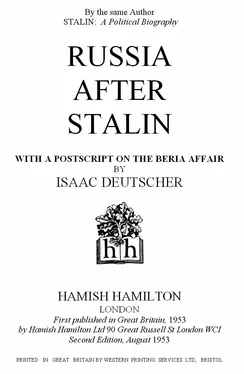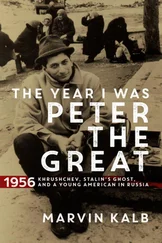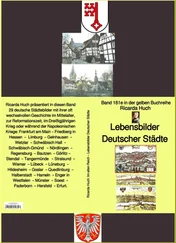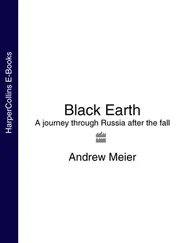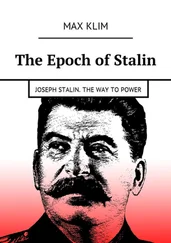But even if it were assumed that the peasants are still full of nostalgia for the pre-collectivist economic system, they are no more free to go back to it than the mass of workers in Ford's factories are to become small, independent artisans.
At the beginning of the Stalin era the peasants were kept within the collective farms primarily by political force. At its end they are kept within them primarily by the force of economic circumstances, especially by the nature of the technological processes established in agriculture. A collective farm can now no more be broken up into a hundred smallholdings than a great modern liner can be broken up into small sailing boats.
If the present system of farming were to disintegrate, this would be the death sentence to innumerable human beings, town-dwellers and peasants alike. Even if a large section of the peasantry were still bent on demolishing the collectivist structure, there is no reason to suppose that Russia, under whatever regime, would allow this sectional interest to drive her to commit national suicide.
A similar view has recently been taken by so well-known and extreme a critic of Soviet agricultural policy as Dr. N. M. Jasny, quoted before. While in Dr. Jasny the anti-Soviet emotionalist is sometimes at loggerheads with the scholar, he nevertheless argues from a thorough knowledge of Soviet agriculture. In the January 1953 issue of the Sotsialisticheskii Vestnik he published an essay which was a cri de coeur against those ‘irresponsible’ Russian emigre politicians who ‘promise’ the peasants that, after the overthrow of the Soviet regime, they will abolish the collective farms.
Dr. Jasny argues that if Russian farming were to go back to the pre-collectivization System ‘it could feed barely half the present urban population. Consequently a simple return to those forms would be equivalent to a huge calamity.’ He also argues that if the anti-Bolsheviks were to assume power, they would have to re-enforce the compulsory food deliveries introduced by Stalin in order to prevent starvation in the towns. ‘What will the Russian people eat after the overthrow of the Soviet regime and in what will they be clad?’ It is enough to pose this question, says Dr. Jasny, to see the complete unreality of promising the peasants ‘a free choice of the forms of farming’.
He concludes: ‘I think that the preservation of the collective farms is inevitable for an indefinite time, for, in the event of their abolition., the situation after liberation from Stalinist rule, which will be difficult enough anyhow, will amount to a most enormous catastrophe.’
It is easy to see why Russian anti-Bolshevik politicians are loath to accept this view. If they did accept it., they could in effect only promise the Russian peasants that they would virtually continue the agricultural regime established by Stalin. In this instance Dr. Jasny, however, argues from realities, not from the hallucinations of political quixotry. He analyses the technological structure of Soviet farming to prove that it does not permit any break-up into smallholdings.
Most of the Soviet tractors are of the ‘Leviathan’ type, larger than any known outside Russia and useful only on giant farms. This type of machine., says Dr. Jasny, could be replaced by smaller ones in the course of many years (and with the help of American lend-lease deliveries!) so as to allow for a break-up of the present collective farms into smaller (but still collective) farms. But if the choice is to be only between smaller and larger collective farms, and if even this choice may become available only after a re-equipment taking many years, then the mountain of the anti-Stalinist ‘revolution’ in farming would give birth to no more than a mouse. All the same, the argument serves to underline the fact that Russia cannot afford to renounce even collectivization, that once most hateful and still most controversial part of the legacy of the Stalin era.
Nor is there any way back for Russia from public ownership and planning.
Even in capitalist countries there seems to have been not a single significant instance of any sector of the economy which had long been publicly owned and publicly managed being handed back to private hands. [12] The ‘re-privatization’ of the British steel industry under Mr. Churchill’s government has no bearing on the argument, because that industry had been nationalized de jure rather than de facto only just before the Conservative Party returned to office.
The whole of Soviet industry has been built up by the State. No title of private ownership has ever attached to it (except for the negligible remnant of pre-revolutionary industry, which has also been completely re-equipped by the State).
This fact has sunk deeply into the mind of the Russian people. Any form of private ownership in industry is to them an anachronism as repugnant and irrational as slavery or serfdom is to the British or the American peoples.
Of this we have incontroverüble evidence: among the many political groups formed in the West by the new Soviet refugees, each of which swears to destroy the whole structure of Stalinism to its very foundations, none has dared to write into its programme the abolition of public ownership of industry. On the contrary, each group ardently swears to preserve it. If this is the mood among emigres, among the victims and the extreme opponents of Stalinism, it can be imagined how strong the attachment to public ownership is among the people in the Soviet Union. [13] In 1945-6 the author, then a correspondent for British newspapers in Germany, interviewed on this subject hundreds of Soviet ‘displaced persons’. He did not meet a single person among them who reacted otherwise than with amazed indignation to the mere suggestion that public ownership might be replaced by private enterprise in Russia. Only citizens of the countries annexed by Russia in 1939-40 met the suggestion with divided opinions and most often with indifference.
With public ownership goes planning — indeed, it is inseparable from it. Even the most old-fashioned industrialist ‘plans’ the work of his own business. Trusts and syndicates plan and coordinate the productive processes within the concerns under their control. Public ownership ipso facto makes of the whole national industry a single concern which cannot be run without comprehensive planning. The method may undergo many important modifications. It may be more or less bureaucratic, more or less centralist, or more or less elastic and efficient; but for Russia to abandon planning would be to condemn herseif to economic anarchy and ruin.
Such is the legacy of the Stalin era that posterity can neither scrap it nor get away from it. Therein consisted the greatness of that era. Yet such was also its misery and squalor that in order to make proper use of its enduring achievements, the Soviet people will be compelled sooner or later to transcend Stalinism.
Stalinism had its roots in the backwardness of Russia; but it has overcome the backwardness and has thereby potentially disestablished itself. For a time it may continue to haunt the Russia of its own making as a ghost from the past. The ‘ghost’ still wields all the material instruments of power; and no one can say how and when it will relinquish them or, alternatively, who will wrest them from its hands, and when. This is not a forecast of startling events, but merely a statement of the fact that a profound contradiction is maturing between, to use the Marxian term, the social and economic structure and the political superstructure of post-Stalinist society.
In the analysis of any long-term historical trend, contemporaries, even if they grasp correctly its general direction, can never be sure just how far the trend has gone at any particular time. We have no yardstick by which to measure history's molecular processes nor can we determine when those processes may coalesce to produce an epoch-making event. In the case of Russia, the measuring is the more difficult because we can know only the broad outline of the trend and we have had little or no insight into the molecular processes.
Читать дальше
